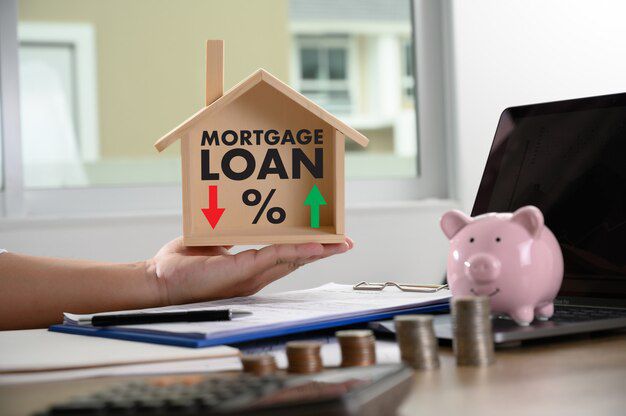

Upto 14-20% Returns Per Annum T/C* Applied*
Popup Title
This is a popup message.
- admin
- Fund-Equity-Advisory
Fixed or Floating Home Loan Interest Rate: Which is Better?
Buying a home is a monumental financial decision, often accompanied by the need for a home loan.
Among the many choices you'll face, selecting the right type of interest rate—fixed or floating—is crucial.
The type of interest rate you choose not only affects your monthly EMI (Equated Monthly Installment) but also your overall financial stability.
This article explores the differences between fixed and floating home loan interest rates, their pros and cons, and how to decide which is better for you.
What is a Fixed-Rate Home Loan?
A fixed-rate home loan features a constant interest rate throughout the loan tenure.
This means your EMIs remain the same, providing stability and predictability.
Advantages of Fixed-Rate Loans
1. Predictable Payments:
With no fluctuations in the interest rate, you can plan your budget effectively, ensuring consistent financial management.
2. Protection Against Rising Rates:
Fixed rates safeguard borrowers from market fluctuations, making them an ideal choice when interest rates are expected to rise.
3. Simplified Financial Planning:
Since your EMI remains constant, long-term financial planning becomes easier, and you can focus on other financial goals.
Disadvantages of Fixed-Rate Loans
1. Higher Initial Interest Rates:
Fixed-rate loans often have higher starting rates than floating-rate loans.
2. No Benefit from Rate Cuts:
If market rates drop, borrowers with fixed-rate loans miss out on potential savings.
When to Choose Fixed-Rate Loans?
1. You prefer stability and consistent EMIs.
2. Interest rates are expected to rise in the near future.
3. You want to avoid the risk of market volatility.
What is a Floating-Rate Home Loan?
Floating-rate home loans, also known as variable-rate loans, have an interest rate that fluctuates with market trends. These loans are linked to a benchmark rate, such as the repo rate, which is periodically adjusted.
Advantages of Floating-Rate Loans
1. Lower Initial Rates:
Floating rates typically start lower than fixed rates, offering immediate savings on EMIs.
2. Potential Savings Over Time:
If market rates decrease, your interest rate reduces, leading to lower EMIs.
3. No Prepayment Penalties:
Borrowers can prepay or foreclose floating-rate loans without incurring additional costs.
Disadvantages of Floating-Rate Loans
1. Unpredictable EMIs:
Monthly payments can increase or decrease based on market trends, adding uncertainty.
2. Market Dependency:
Borrowers bear the risk of higher repayments if interest rates rise.
When to Choose Floating-Rate Loans?
1. You expect market rates to decline in the future.
2. You can manage variable EMIs without financial strain.
3. You’re taking a long-term loan with potential for market-driven savings.
Fixed vs. Floating Rate Home Loans: A Comparison
|
Aspect |
Fixed-Rate Loans |
Floating-Rate Loans |
|
Interest Rate |
Constant throughout tenure |
Variable, linked to market rates |
|
EMI Stability |
Predictable |
Fluctuates with market trends |
|
Initial Interest Rate |
Higher |
Lower |
|
Market Dependency |
Independent |
Dependent |
|
Prepayment Penalty |
May apply |
Typically waived |
Factors to Consider While Choosing
1. Financial Stability:
If you have a stable income and prefer consistent expenses, a fixed-rate loan might be better. Floating-rate loans require the flexibility to manage fluctuating EMIs.
2. Market Conditions:
Analyze interest rate trends. If rates are expected to rise, opt for a fixed-rate loan. If rates are likely to fall, a floating-rate loan can help you save.
3. Loan Tenure:
Fixed-rate loans are ideal for short tenures, whereas floating rates are more suitable for long-term loans where market conditions can play in your favor.
4. Risk Appetite:
Fixed-rate loans provide peace of mind for risk-averse borrowers. Floating rates, while riskier, offer the chance to benefit from declining interest rates.
Switching Between Fixed and Floating Rates
Some lenders allow borrowers to switch between fixed and floating rates during the loan tenure. This option can be advantageous if your financial situation or market conditions change.
What to Consider Before Switching?
1. Timing and Costs:
Assess any fees or penalties associated with switching. Ensure the savings outweigh the costs.
2. Market Trends:
Review current and projected market rates to determine whether switching is beneficial.
3. Personal Financial Goals:
Ensure the new loan structure aligns with your financial objectives.
Key Documents to Prepare
Before finalizing your loan, ensure you have all the essential property documents, such as the Sale Deed, encumbrance certificate, and property tax receipts. These documents are critical for securing a home loan.
Read More: Essential Property Documents
Understanding the Sale Deed
The Sale Deed is a crucial legal document that signifies property ownership transfer. It is often required during the home loan application process, regardless of the interest rate type.
Learn More: What is a Sale Deed?
Conclusion
Choosing between fixed and floating home loan interest rates depends on your financial situation, market trends, and personal preferences.
Fixed-rate loans offer stability and predictable payments, making them ideal for risk-averse borrowers.
Floating-rate loans provide flexibility and potential savings, especially in a declining interest-rate environment.
Evaluate your financial goals, consider market conditions, and consult with your lender to make the best decision.
Whether you choose a fixed or floating rate, understanding your options will ensure a smoother and more manageable repayment journey.
For expert guidance on property loans and related services, visit 2A Company.






